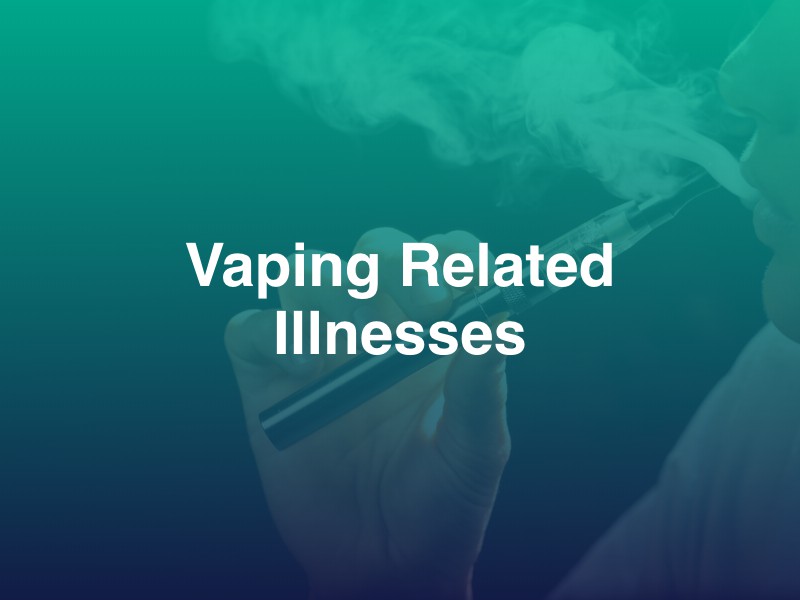Vaping has grown in popularity with the rise of e-cigarettes, vape pens, and other such devices. These battery-powered devices are filled with liquids that are heated into an aerosol (a “vapor”) consisting of fine particles. Vaping is the act of inhaling and exhaling the aerosol/vapor produced by an e-cigarette or similar device.
The devices typically contain propylene glycol or vegetable glycerin-based liquids combined with nicotine, flavoring such as diacetyl, and varying amounts of metals and chemicals – many of them toxic – but not tobacco. Some use these devices to vape THC (the psychoactive compound in marijuana that produces the “high” sensation).
The Problem with Vaping
The problem with vaping is that it was “sold” as a safer alternative to smoking and even a way of smoking cessation for those who wished to quit smoking. Nicotine is still the primary agent in both regular and e-cigarettes, however; it is highly addictive no matter what form it is in.
Use among teens has skyrocketed in recent years, as children have been drawn to these products under the assumption that they are harmless when, in fact, they are not. The problem has grown to the point that the U.S. Surgeon General has declared e-cigarette use among youth an epidemic in the United States. Vaping devices come in an abundance of flavors and are packaged so that they look like harmless flash drives and youth are able to conceal, charge these devices on their computers at school, and use them there. The company that markets these devices is clearly profiting, as the most profitable one, JUUL, is currently worth about $38 billion.
No matter what the age of the user, nicotine has multiple harmful effects upon the body and brain, including the heart, hormones, and gastrointestinal system; it stimulates the adrenal glands, increases heart rate, blood pressure, breathing, and even can cause the pancreas to produce less insulin, increasing glucose levels. Nicotine can also slow brain development in kids and teens, and have a negative impact memory and concentration, learning, attention, mood. This is clearly problematic, as so many of our youth are buying these products. In fact, current statistics show (Cullen et al., 2018) the following:
- In the United States, youth are more likely than adults to use e-cigarettes.
- In 2018, more than 3.6 million U.S. middle and high school students used e-cigarettes in the past 30 days, including 4.9% of middle school students and 20.8% of high school students.
- Among high school students, current e-cigarette use increased from 1.5% (220,000 students) in 2011 to 20.8% (3.05 million students) in 2018.
- Also among high school students, during 2017–2018 current use of any flavored e-cigarettes increased among current e-cigarette users (from 60.9% to 67.8%).
- Among middle school students, current e-cigarette use increased from 0.6% in 2011 (60,000 students) to 4.9% (570,000 students) in 2018.
- During 2017–2018, current e-cigarette use increased by 48% (from 3.3% to 4.9%).
E-cigarettes can lead to cigarette smoking as the nicotine in some of these products is clearly addictive. Vaping has also been found to irritate the lungs and puts all users at risk of serious lung damage and, based on the latest outbreak, possibly death.
Vaping Illnesses and Deaths
On October 8th, the United States Center for Disease Control and Prevention (CDC, 2019) announced that the total number of lung injury cases related to e-cigarette or vaping products rose to 1,299 – up from 1,080 the previous week. Currently 49 U.S. states (all but Alaska) along with Washington, D.C. and the U.S. Virgin Islands have reported that people have been sickened or have died from the use of these products.
So far, 26 deaths have been confirmed in 21 states: Alabama, California (3), Connecticut, Delaware, Florida, Georgia (2), Illinois, Indiana, Kansas (2), Massachusetts, Michigan, Minnesota, Mississippi, Missouri, Nebraska, New Jersey, New York, Oregon (2), Pennsylvania, Texas, and Virginia. The are other deaths that are still under investigation. The median age of patients who died was 49 years and ages ranged from 17 to 75 years.
Some Important Vaping Statistics You Should Know
While the tally of injuries and deaths from vaping rise, health officials are still unable to locate the source. It appears that most of the problem products were purchased away from licensed dispensaries (e.g., from friends, family, or illicit sources).
- As of October 8, 2019, 1,299 lung injury cases associated with using e-cigarette, or vaping, products have been reported to CDC from 49 states and 1 U.S. territory.
- To date, 26 deaths have been confirmed in 21 states.
- All patients have reported a history of using e-cigarette, or vaping, products. About 58% reported using nicotine-containing products; 13% reported exclusive use of nicotine-containing products.
- Most patients reported a history of using THC-containing products. The latest national and regional findings suggest products containing THC play a role in the outbreak – particularly those obtained off the street. About 76% reported using THC-containing products; 32% reported exclusive use of THC-containing products.
- Among patients with age and sex data:
- Approximately 70% of patients are male
- Approximately 80% of patients are under 35 years old. 15% of patients are under 18 years old. 21% of patients are 18 to 20 years old
- 18% of patients are 21 to 24 years old
- 26% of patients are 25 to 34 years old
- 20% of patients are 35 years or older
Possible Culprits in Vaping Products
According to some experts, the culprit might be certain chemicals like vitamin-E acetate that are used to emulsify THC and CBD in illegal, unregulated vaporizers. One study of found that out of 12 illicit THC vape cartridges tested, 75% contained dangerously high levels of vitamin E acetate, while all of the illegal vapes contained pesticides (pesticides can break down into poisonous hydrogen cyanide when inhaled).
A Colorado lab found that some of the cheaper pens contained the chemical cadmium; cadmium oxide fumes are highly toxic to organs and injure lung cells, while the Mayo Clinic’s study found that patients had fluid accumulation and severe tissue and cell damage. Their study of 17 lung tissue samples revealed that the injuries to lungs resembled severe chemical burns similar to those caused by a WWI biological weapon called mustard gas.
Still, not all vaping products that made people sick were purchased illicitly; one patient who survived purchased non-THC Juul pods from a licensed dispensary in Oregon. His doctor told him it was the oil build-up in his lungs that had caused his near-death illness.
Symptoms of Lung Injury
Patients have reported symptoms such as:
- Cough
- Shortness of breath
- Chest pain
- Nausea
- Vomiting
- Abdominal pain
- Diarrhea
- Fatigue
- Fever
- Weight loss
Some patients have reported that their symptoms developed over a few days, while others have reported that their symptoms developed over several weeks.
If you have recently used an e-cigarette, or vaping, product, see a healthcare provider immediately if you develop any of the symptoms listed above.
Cautions and Recommendation
Remember that pregnant women and youth are especially vulnerable:
- Most e-cigarettes contain nicotine, which is addictive and toxic to developing fetuses.
- Nicotine exposure can also harm adolescent brain development, which continues into the mid-20s.
Avoid buying any type of e-cigarette or vaping products off the street.
If you have questions about CDC’s investigation into the lung injuries associated with use of electronic cigarette, or vaping, products, contact CDC-INFO or call 1-800-232-4636.
Resources
https://www.businessinsider.com/timeline-of-vape-related-illnesses-and-deaths-2019-9#september-6-5
https://www.drugwatch.com/e-cigarettes/side-effects/
https://www.cdc.gov/tobacco/basic_information/e-cigarettes/severe-lung-disease.html
https://www.cdc.gov/tobacco/basic_information/e-cigarettes/severe-lung-disease.html#epi-chart
https://www.centeronaddiction.org/e-cigarettes/recreational-vaping/what-vaping
https://childmind.org/article/teen-vaping-what-you-need-to-know/
https://thorax.bmj.com/content/73/12/1161
https://www.sciencedirect.com/science/article/pii/S0091743516303413?via%3Dihub
https://www.unh.edu/healthyunh/blog/tobacco/2017/11/dangers-nicotine
https://www.youtube.com/watch?v=efGkEo7ZSeI
https://www.youtube.com/watch?v=0e-fOM1dx3s
https://www.ch.ic.ac.uk/vchemlib/mim/bristol/thc/thc_text.htm
https://www.cdc.gov/tobacco/basic_information/e-cigarettes/about-e-cigarettes.html
https://www.cdc.gov/mmwr/volumes/67/wr/mm6745a5.htm?s_cid=mm6745a5_w
Cullen KA, Ambrose BK, Gentzke AS, Apelberg BJ, Jamal A, King BA. Notes from the Field: Use of Electronic Cigarettes and Any Tobacco Product Among Middle and High School Students — United States, 2011–2018. MMWR Morb Mortal Wkly Rep 2018;67:1276–1277. DOI: http://dx.doi.org/10.15585/mmwr.mm6745a5external icon





No Comment